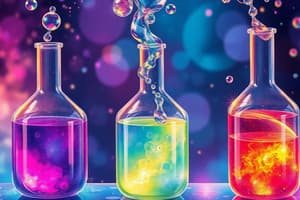Podcast
Questions and Answers
What is the primary function of a buffer solution?
What is the primary function of a buffer solution?
- To completely neutralize acids and bases
- To react with all added substances
- To increase the concentration of ions in a solution
- To maintain pH stability in a solution (correct)
Which components are typically found in a buffer solution?
Which components are typically found in a buffer solution?
- An inert salt and a volatile compound
- A strong acid and a strong base
- A metal ion and a non-metal ion
- A weak acid and its conjugate base (correct)
What happens to the pH of a buffer solution when a small amount of strong acid is added?
What happens to the pH of a buffer solution when a small amount of strong acid is added?
- The pH changes only slightly (correct)
- The pH becomes neutral
- The pH increases significantly
- The pH decreases dramatically
In what scenario would a buffer solution be particularly useful?
In what scenario would a buffer solution be particularly useful?
Which statement best describes how a buffer maintains pH balance?
Which statement best describes how a buffer maintains pH balance?
Flashcards
Buffer Solution
Buffer Solution
A solution that resists changes in pH when small amounts of acid or base are added.
pH
pH
A measure of the acidity or basicity of a solution.
Acid
Acid
A substance that releases hydrogen ions (H+).
Base
Base
Signup and view all the flashcards
Resist pH change
Resist pH change
Signup and view all the flashcards
Components of a buffer
Components of a buffer
Signup and view all the flashcards
Study Notes
Definition and Purpose
- A buffer solution is a solution that resists changes in pH when small amounts of acid or base are added to it.
- This resistance to pH change is crucial in many chemical and biological systems.
- Buffer solutions maintain a relatively constant pH, which is important for enzyme activity, chemical reactions, and biological processes.
Components of a Buffer Solution
- Buffer solutions typically consist of a weak acid and its conjugate base or a weak base and its conjugate acid.
- The weak acid/base partially dissociates in solution.
- The conjugate base/acid is formed by either the loss or gain of a proton (H⁺).
Acidic Buffer Solutions
- Composed of a weak acid and its conjugate base.
- The weak acid's equilibrium provides a source of H⁺ ions to neutralize added OH⁻ ions.
- The conjugate base can neutralize added H⁺ ions.
- Examples include acetic acid/acetate and carbonic acid/bicarbonate.
Basic Buffer Solutions
- Composed of a weak base and its conjugate acid.
- The weak base's equilibrium provides a source of OH⁻ ions to neutralize added H⁺ ions.
- The conjugate acid can neutralize added OH⁻ ions.
- Examples include ammonia/ammonium and tris/trishydrochloride.
Buffer Capacity
- The buffer capacity is the amount of acid or base that a buffer solution can neutralize before a significant change in pH occurs.
- The capacity depends on the concentrations of the weak acid/base and its conjugate.
- Higher concentrations result in a greater buffer capacity.
Calculating pH of a Buffer Solution
-
The Henderson-Hasselbalch equation is used to calculate the pH of a buffer solution.
-
This equation relates the pH of the buffer to the pKa of the weak acid and the ratio of the concentrations of the weak acid and its conjugate base.
-
Henderson-Hasselbalch equation: pH = pKa + log([conjugate base]/[weak acid])
Factors Affecting Buffer Capacity
- The concentrations of the weak acid and its conjugate base directly impact the buffer's capacity to neutralize added acid or base.
- The pKa value of the weak acid affects the effectiveness of the buffer at a given pH.
- A pKa near the desired pH will lead to a more effective buffer.
Applications of Buffer Solutions
- Maintaining a constant pH in biological systems.
- Controlling the pH in chemical reactions.
- Standardizing solutions in titration processes.
- Used in industrial processes such as in the food and pharmaceutical industries.
Limitations of Buffer Solutions
- There is a limited capacity for buffering before significant pH changes occur.
- Exceeding the buffer capacity will result in a rapid change in pH.
- The buffer's effectiveness is limited to a specific pH range around its pKa.
Preparing Buffer Solutions
- The precise concentrations of the weak acid/base and its conjugate must be known to create a desired buffer solution.
- The pKa of the compound, or the pH we want the solution to buffer to, will help determine the specific ratios of the compounds in the solution.
- This calculation is assisted by the Henderson-Hasselbalch equation.
Studying That Suits You
Use AI to generate personalized quizzes and flashcards to suit your learning preferences.




